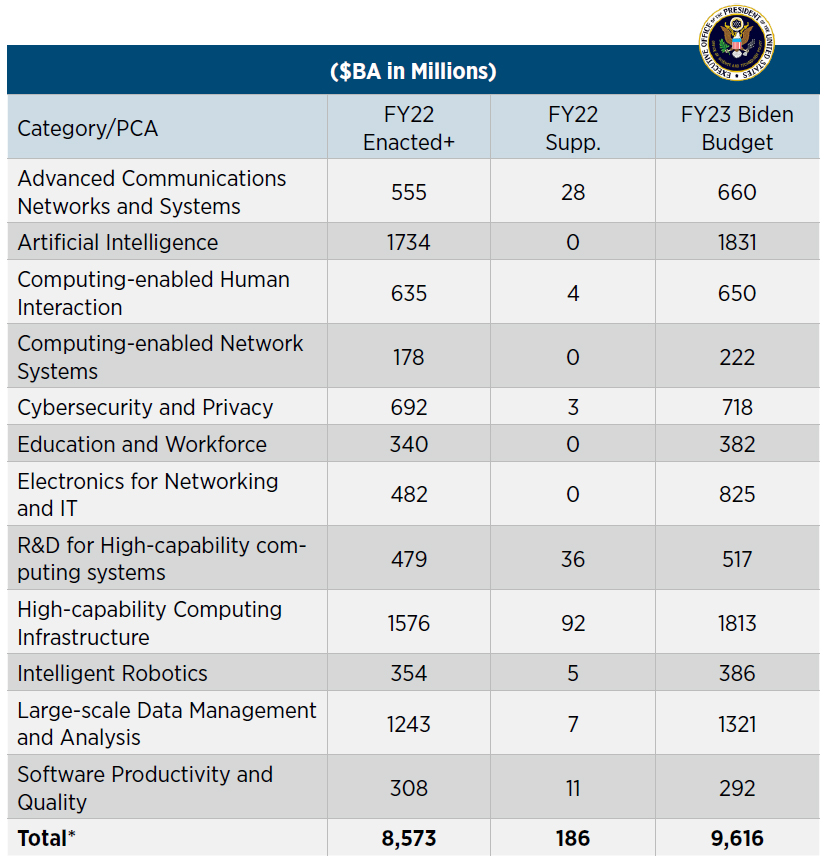January 04, 2023
R&D in IT and Artificial Intelligence: Resources and Focus Areas


New insights into potentially transformative federal investments in Artificial Intelligence (AI), Machine Learning (ML), and research on networking, supercomputing, and big data were released on November 29, when the National Science and Technology Council (NSTC) within the Office of Science and Technology Policy (OSTP) completed its supplement to the President’s FY23 budget. NSTC is tasked with ensuring that science and technology programs and policy decisions across government align with the President’s objectives. For this budget supplement, NSTC relied on two of its subcommittees for the analysis: the Machine Learning and Artificial Intelligence Committee (MLAI), with analysis done by the National Artificial Intelligence Initiative Office (NAIIO) established by the National Artificial Intelligence Initiative Act of 2020, and the Network and Information Technology Research and Development (NITRD) program, which was founded under the terms of the High Performance Computing Act of 1991.


Chart I: Total Unclassified Federal IT R&D and AI Funding, FY21-FY23. Source: NITRD/NAIIO Budget Supplement FY23, November 2022
RESOURCES
The NSTC budget supplement is a technical requirement and an analytical exercise, not a request for additional funds, which are often termed “supplementals.” The Council reports resources and activities across government for programs that represent significant information technology research and development and foundational work in artificial intelligence. As seen in Chart I, the report covers annual and supplemental funding for fiscal years 2021 (actual), 2022 (enacted) and 2023 (requested) by agency component and program area. The FY23 report, for the first time, includes all unclassified Department of Defense programs and funds, so it is a more comprehensive look at IT R&D investments than has been available before, but the change makes year-to-year comparisons a challenge.
NSTC organizes the IT R&D spending in 12 categories, or Program Component Areas (PCA)s, as defined by NITRD. It further breaks the funding down by Department or major agency, and also maps IT R&D and AI projects to Presidential priorities in areas such as pandemic prevention and climate resilience that were required by the Office of Management and Budget directive Multi-Agency Research and Development Priorities for the FY 2023 Budget in August 2021. Chart II provides a summary of the funding by PCAs for FY22, FY22 supplemental funds, and FY23.
Over half of the FY23 funding goes to three PCAs: 19% to Artificial Intelligence; 19% to High-capability Computing Infrastructure; and 14% to Large-scale Data Management and Analysis. Artificial Intelligence gets an additional boost from funding counted separately by NSTC. National Science Foundation-led AI research is estimated to be $73 million in FY22 and $98 million in FY23, bringing AI close to $1.9 billion in FY23. However, the report notes that agency AI budgets are broader than the tightly defined AI PCA category. Other categories of R&D enable AI and need to be included for a comprehensive funding picture. The report’s AI section (Table 2.1-2) shows the AI Budget for over 40 agencies/subagencies. As an example, the AI Budget at National Institute for Science and Technology (NIST) is $46.8 million for FY23: $40.7 million in the AI category itself, $2.4 million for R&D for High- Capability Computing Systems, and $3.2 million in Intelligent Robotics and Autonomous Systems.
Examining the data by Agency or Department provides other insights. The FY23 budget for IT R&D and AI is estimated at $9.6 billion, an increase of $1.0 billion. As illustrated in Chart III, almost a third of that total is for the Department of Defense (DOD), which includes funding for the Defense Advanced Research Projects Agency (DARPA). However, some of the increase was due to better reporting. The Department of Health and Human Services represents close to a quarter of the total funding; the vast majority of that is for the National Institutes of Health (NIH). The National Science Foundation covers more than $2 billion, over 20% of the total. Next is the Department of Energy, with $1.4 billion, or 14% of the total. Rounding out the top five is Commerce (which houses NIST, NOAA and the National Telecommunications and Information Administration (NTIA) at 4% of the total.
Spending patterns for IT R&D and AI differ from those of all federal government R&D. The Congressional Research Service (CRS) analyzed the FY23 Biden R&D budget and estimated the total at $204.9 billion overall. CRS found that eight agencies/departments spend over 97% of that funding, a similar concentration as in the IT R&D/AI funding. However, the distribution of funds to agencies or departments is different, with NSF and the Department of Commerce (with NIST and NOAA) having a much larger share of IT R&D than overall R&D, and DOD and HHS having a smaller share of IT R&D than they do of overall R&D. The CRS analysis for all R&D funding by agency is 41% for DOD, 30% for HHS (primarily NIH), 12% for DOE, 7% for NASA, 4% for NSF, 2% for USDA and 1% each for the Departments of Commerce and Veterans Affairs.


Chart II: Total R&D and AI Funding by PCA Category, FY22 Enacted and FY23 Biden Budget Request *Totals may not add due to rounding. +FY22 totals did not include complete Department of Defense reporting. Source: FBIQ, NITRD/NAIIO Budget Supplement FY23, November 2022
FOCUS AREAS
The NSTC report includes nearly 50 pages of IT R&D and AI projects by PCA category. Selected highlights include:
Advanced Communications Networks and Systems: NIST, NSF, DOE and the Air Force are researching quantum communications and network capabilities. NSF is looking at AI/ML to improve the communications layer in convergent networks, and multiple agencies are focused on resilient and intelligent next-generation networks and systems with 5G architecture.
Artificial Intelligence: The Department of Transportation is exploring and developing AI systems for planning, design and operation of the national highway network. VA and its academic and industry partners support a new National Artificial Intelligence Institute to develop AI capabilities to better treat veterans and VA sponsors Tech Sprint competitions to spur innovation. DoE is looking at AI and ML for scientific research management of complex processes and to support decision making. NIH is focused on Ultrascale machine learning to support Alzheimer’s research, applying AI methods to very large databases of genetic, imaging and cognitive data.
Computing-enabled Human Interaction: HHS is researching evidence-based tools to make care transitions better for patients, and is funding a clinical decision support initiative. The Department is also developing a digital health framework and guide with an emphasis on equity in care. NIH researchers are developing a “Ghost in the Machine” program to develop revolutionary new implantable neuro devices that meld brain, computer and behavior aspects.
Computing-enabled Network Systems: NSF is developing a Future Manufacturing cyber track. DOT is focused on a Smart Grid experimental infrastructure with industrial control systems and block chain controls as well as electric vehicle integration.
Cybersecurity and Privacy: DARPA and NSF are both working on active social engineering defense and attribution to support the deterrence of malicious cyber activity. Multiple agencies are researching R&D for cybersecurity, risk and vulnerability management, and information integrity.
Education and Workforce: Most agencies report fellowships, development programs, scholarships and training programs to recruit and retain a diverse population of highly-skilled researchers, and provide them access to high-performing computing and datasets.
Electronics for Networking and IT: NSF is supporting fundamental research in disruptive technologies and models in computing and communication. DARPA has an Electronics Resurgence Initiative that addresses cost, modeling, and throughput of electronics design and research.
R&D for High-capability computing systems: DOE’s Exascale Computing Project will develop a new class of high-performing computing with performance at 1,000 times today’s most advanced petaflop machines. NIH will expand its CloudLab for researchers to experiment and test cloud computing capabilities. NIST and industry partners will focus on a semiconductor and future computing partnership to guide research in academia.
High-capability Computing Infrastructure: NASA supports a High-end computing capability project to enable large-scale modeling, simulation and analysis for NASA missions and research.
Intelligent Robotics: NIST is looking at developing measurement science that focuses on a robot’s ability to grasp and manipulate machinery and tools in a safe manner for industrial arm applications. NASA is studying multi-robot coordination for planetary exploration.
Large-scale Data Management and Analysis: NIH is researching mining of real-time social media big data to monitor and predict contagious human illnesses.
Software Productivity and Quality: NIST is providing a structured, complete and orthogonal classification of software weaknesses. NIST and the intelligence community are developing technology to inspect AIs to identify and disrupt Trojan attacks.


Chart III: IT R&D and AI Funding by Agency or Department, FY23 Biden Budget Source: FBIQ, NITRD/NAIIO Budget Supplement FY23, November 2022
WHAT’S NEXT?
This week, Congress is working on the FY23 appropriations acts funding every agency project highlighted above and the hundreds more included in the NSTC report. After enactment, “new start” projects can proceed, researchers can be hired, and ongoing research may expand. Congress required that the Executive Branch report on IT R&D and AI budgets for transparency and oversight purposes, but the report also serves as a reminder of the breadth and depth of U.S. capabilities, the effect of cooperation between the government and the private sector, and the potentially transformative research spanning the country. These investments bring vast possibilities for breakthroughs—improving public health, climate science, understanding of systems and problems, creating efficiency, and improving national security.
What’s ahead in this area is inspiring. In President Biden’s FY24 Budget, we expect increases over the $9.6 billion planned for FY23. IT R&D and AI investment is a force-multiplier with the potential for leap-ahead technologies that bring economic advantages, push exploration, improve people’s health and safety, and inspire a new generation of creative researchers.